Key takeaways:
- Homelessness is often a systemic issue linked to mental health, addiction, and poverty, requiring a shift from stigma to understanding and support.
- Identifying and addressing the unique challenges faced by marginalized groups, such as refugees and the + community, is essential for effective advocacy and support.
- Building partnerships with local agencies and fostering trust through open communication can lead to more effective community programs and services for homeless individuals.
- Creating awareness through community events helps humanize homelessness, encouraging empathy and reflection among attendees while providing a platform for marginalized voices.
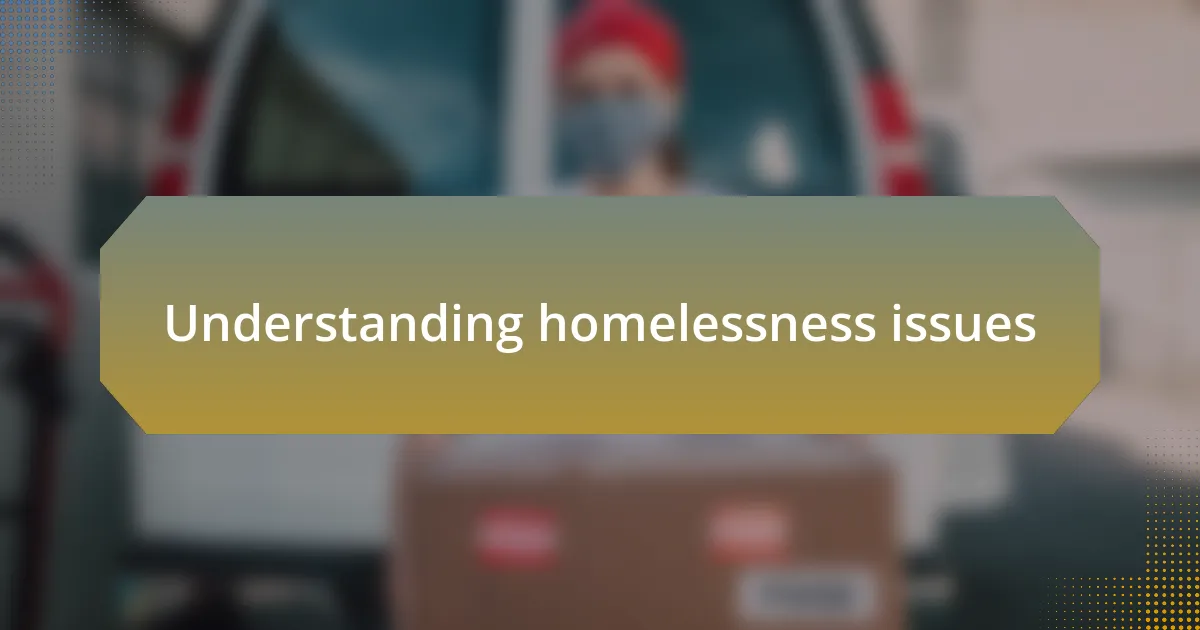
Understanding homelessness issues
Homelessness is a complex issue that affects individuals from various backgrounds, often intertwining with factors like mental health, addiction, and systemic poverty. I vividly remember a conversation I had with a young man named Kevin, who shared how losing his job spiraled him into a series of unfortunate events, ultimately leaving him without a place to call home. His story made me reflect: how many others face similar situations, and what can we do to intervene before it’s too late?
Many people hold misconceptions about homelessness, often viewing it through a lens of stigma. I once attended a community meeting where a homeless woman courageously spoke about her struggles to find stability while battling society’s perceptions. It struck me deeply how these biases can prevent meaningful connections and solutions. What if we shifted our focus from judgment to understanding?
It’s essential to recognize that homelessness is not solely an individual failing but often a systemic issue, rooted in inadequate access to resources and support. I frequently think about the people I see on the streets, often wishing for a chance to share their voices and stories. How can we create a system that acknowledges these narratives and fosters a path toward recovery and reintegration into society?
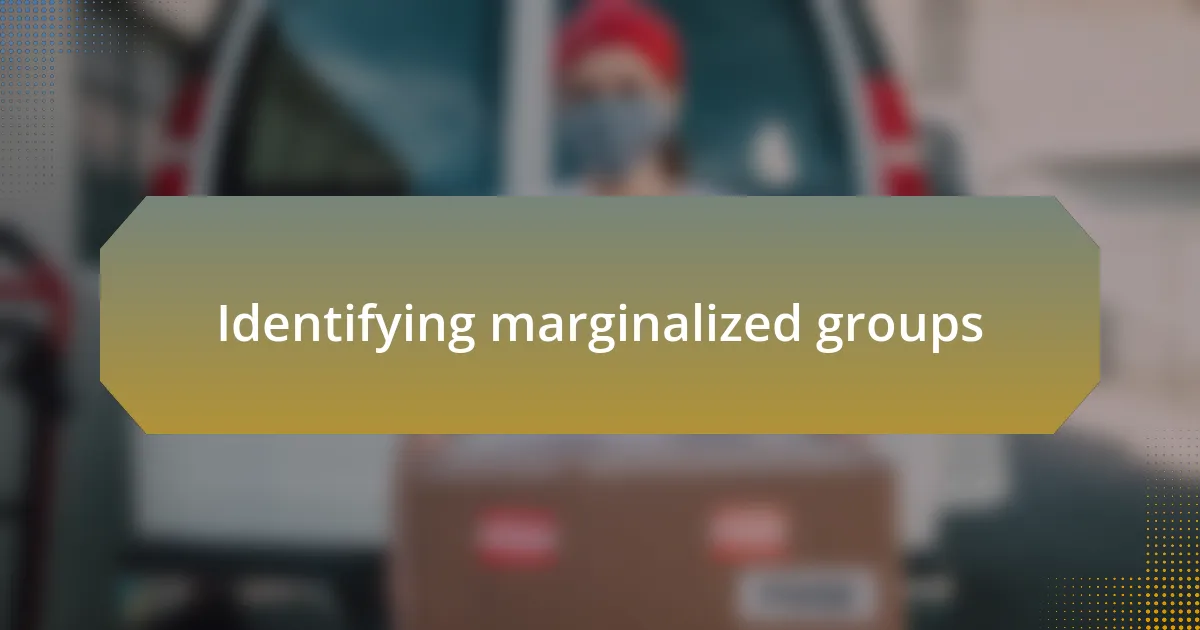
Identifying marginalized groups
Identifying marginalized groups requires a keen awareness of the intersectionality of various identities and circumstances. For instance, during my time volunteering at a local shelter, I encountered multiple families struggling not just with homelessness, but also with the stigma of being refugees. Their dual challenges highlighted how interconnected issues can compound the struggles they face, making it crucial to recognize the various layers of marginalization.
Furthermore, certain demographics, such as the + community, often face unique challenges that contribute to their homelessness. I once met a young woman named Jess who found herself on the streets after her family rejected her for her sexual orientation. Her story is a poignant reminder that identifying marginalized groups means looking beyond the surface; we must consider how societal biases and lack of acceptance can drastically alter someone’s circumstances.
It’s not just about identifying groups, but also about understanding the nuances within those groups. In my experience, many older adults experiencing homelessness often navigate complex health issues that are frequently overlooked. How often do we stop to think about their specific needs? By listening and engaging with these individuals, we can better tailor our advocacy strategies to address the unique barriers they face.
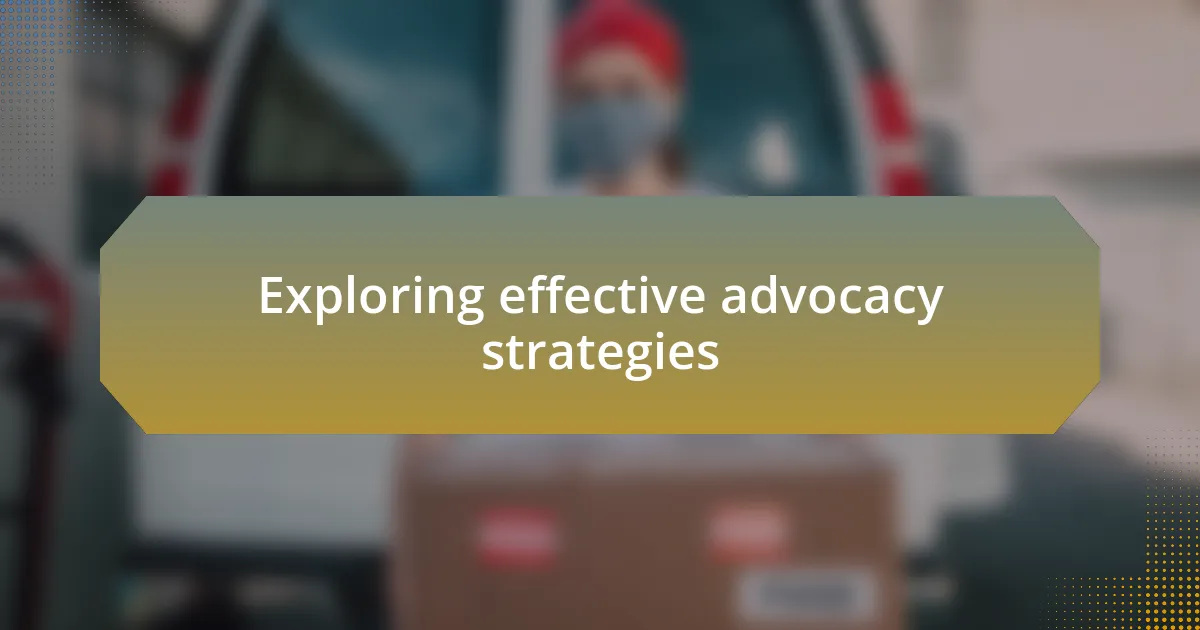
Exploring effective advocacy strategies
Effective advocacy strategies begin with authentic communication and relationship-building. When I first started advocating for homeless individuals, I realized that simply voicing their needs wasn’t enough; I had to listen. I remember sitting down with a group at the shelter, sharing stories over coffee. That experience opened my eyes to their personal struggles and dreams, reinforcing the idea that advocacy is about amplifying their voices, not just speaking on their behalf.
One strategy that often proves impactful is community coalition building. During a recent initiative, I joined forces with local organizations focused on mental health services. Together, we developed workshops that not only addressed basic needs but also offered mental health support—all rooted in the experiences of those we were advocating for. It struck me how powerful it was when individuals felt included in the planning process; they’d share insights that I never could have anticipated on my own. Has anyone else experienced that electrifying moment when collaboration leads to breakthroughs?
Additionally, leveraging storytelling as a tool for advocacy can shift perceptions and challenge stereotypes. In one campaign, we invited individuals experiencing homelessness to share their journeys through a video series. Their raw, honest narratives resonated deeply with the community, sparking conversations and changing mindsets. This, I believe, is where real change begins. When we bring personal experiences to the forefront, we can humanize issues that often feel abstract or distant to the public. Wouldn’t it be incredible if more people engaged with these stories and took action?
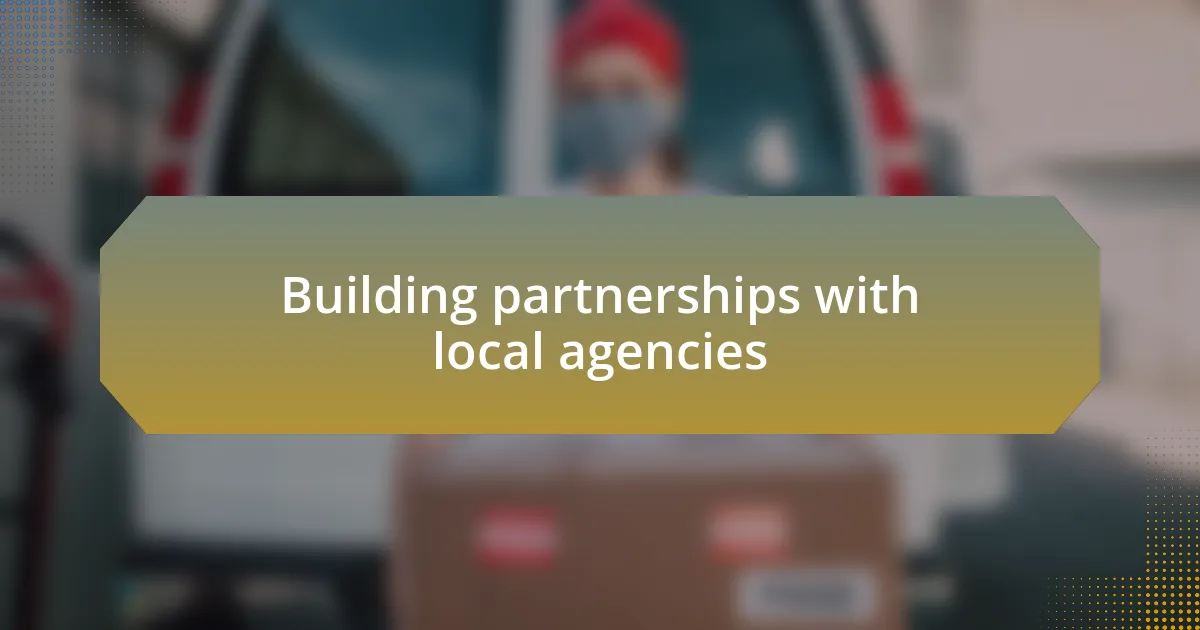
Building partnerships with local agencies
Building partnerships with local agencies is essential for addressing the complex needs of marginalized groups. I recently teamed up with a local food bank and witnessed firsthand the synergy that can emerge when organizations unite for a common purpose. Our joint outreach programs not only provided meals but also connected homeless individuals with vital services like job training and housing assistance. Have you ever felt that sense of achievement when collaboration yields tangible results?
In my experience, cultivating trust with local agencies takes time and effort, but the rewards are immense. I remember pursuing a partnership with a nearby health clinic after hearing from homeless individuals that accessing healthcare was a significant barrier. After several meetings filled with candid discussions about challenges, we aligned our goals and created a seamless referral system. It was these genuine conversations—where I shared their struggles and the clinic listened—that laid the groundwork for a meaningful partnership. How often do we take the time to really understand what others need before we act?
Ultimately, I’ve found that proactive communication is the bedrock of strong partnerships. Recently, I organized a series of town hall meetings, inviting various agencies to engage directly with the community. The lively discussions not only fostered collaboration but also illuminated gaps in services that needed attention. Reflecting on these interactions, I often ask myself: if we actively listen and engage with each other, how much more could we achieve together?
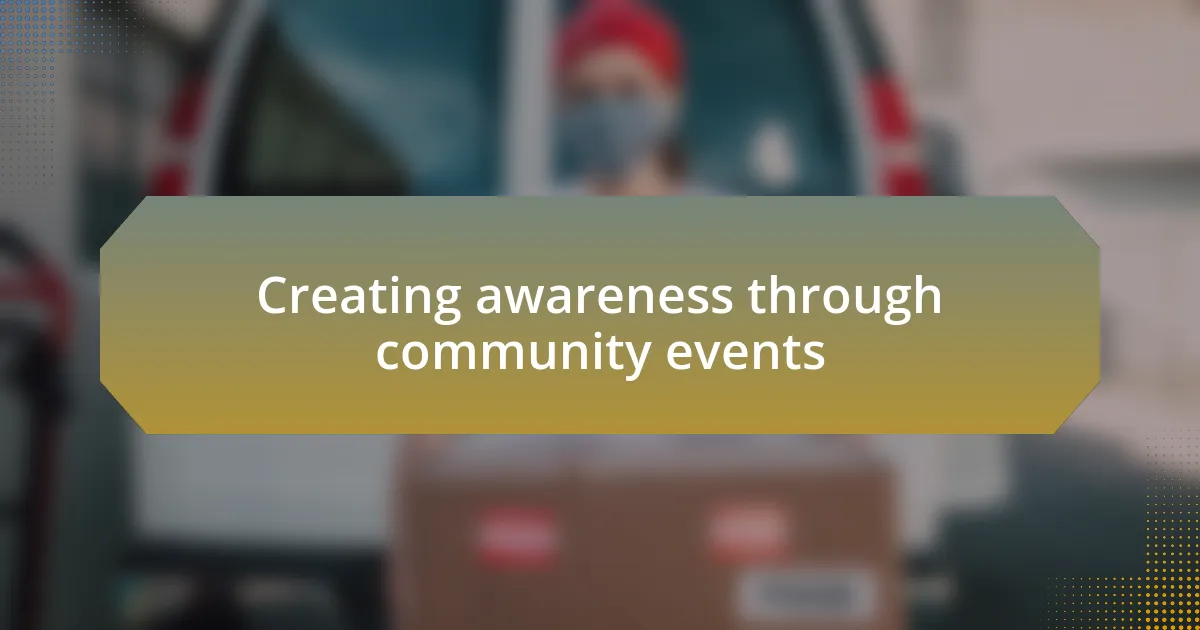
Creating awareness through community events
Creating awareness in our communities through events can be a transformative experience. I vividly recall organizing a local awareness day focused on homelessness, where we transformed a park into an information hub filled with resources and opportunities. The energy was palpable as people from all walks of life stopped by, some learning for the first time about the challenges faced by marginalized groups. Have you ever witnessed firsthand how a single day can spark long-lasting conversations?
One of my most memorable moments occurred when a young participant approached me, sharing how the stories shared by volunteers inspired her to think critically about her own privilege. It reminded me that awareness is not just about information; it’s about prompting reflection and empathy. The conversations that flowed from those personal exchanges were eye-opening, as I saw participants connect with each other on a deeper level. Isn’t it amazing how sharing a story can bridge gaps that seemed impossible to cross?
In my experience, community events can also serve as a platform for marginalized voices. During a panel discussion at one of our outreach events, a homeless individual spoke about their experiences and dreams, captivating the audience. The silence that followed their speech was striking—it showed that these events do more than raise awareness; they humanize issues that are often glossed over. I believe we all have the ability to deepen our understanding by simply listening; how often do we give space for those voices to be heard?
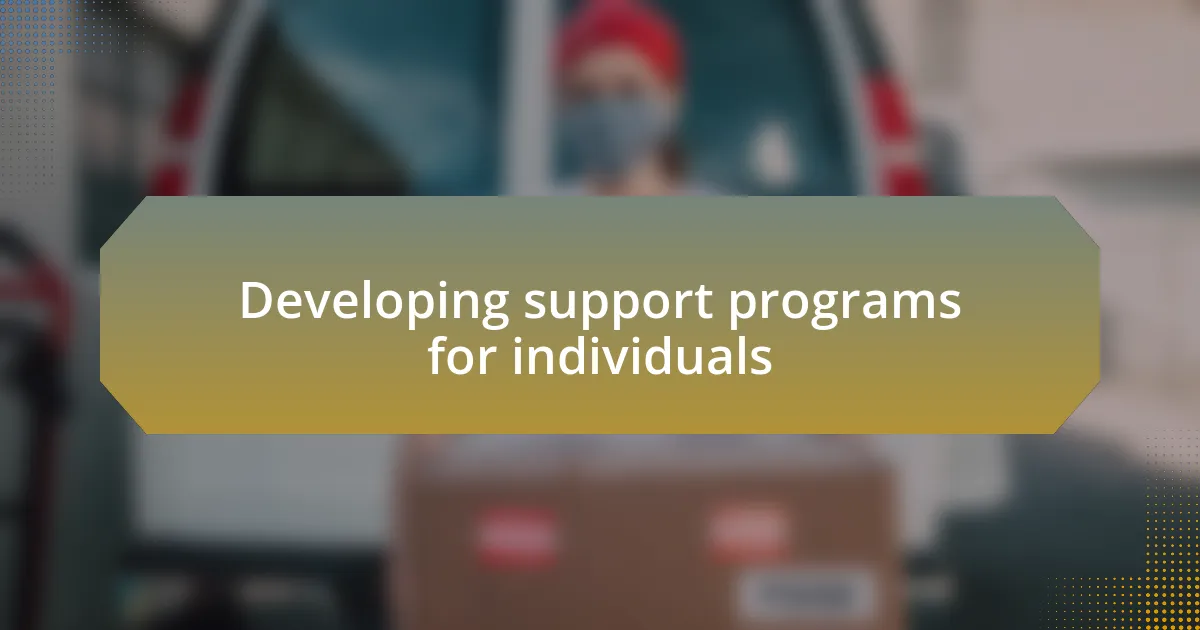
Developing support programs for individuals
Developing support programs for individuals requires a nuanced understanding of their unique needs. I remember sitting with a small group of individuals experiencing homelessness and listening to their stories. One participant shared how locating job opportunities was often an overwhelming task without proper guidance—that moment highlighted the necessity of tailored employment support programs that could truly empower them. Have you ever stopped to consider how crucial it is to provide not just resources, but dedicated mentorship?
As I collaborated with local organizations to create a skill-building workshop, I saw firsthand the positive impact of personal connection. Participants were not just learning new skills; they were forging relationships that provided built-in support systems. It struck me how critical it is to structure these programs around community involvement, promoting a sense of belonging that can help individuals rebuild their confidence and self-efficacy. When was the last time you felt like you truly belonged somewhere?
In crafting these programs, emotional support cannot be overlooked. I recall a participant expressing how simply having someone check in on them made a world of difference. It reinforced my belief that fostering a supportive environment is vital; people need to feel valued, and this emotional component can be the bridge to stabilizing their lives. Isn’t it powerful to think that sometimes, just being there for someone can lead to transformative change?